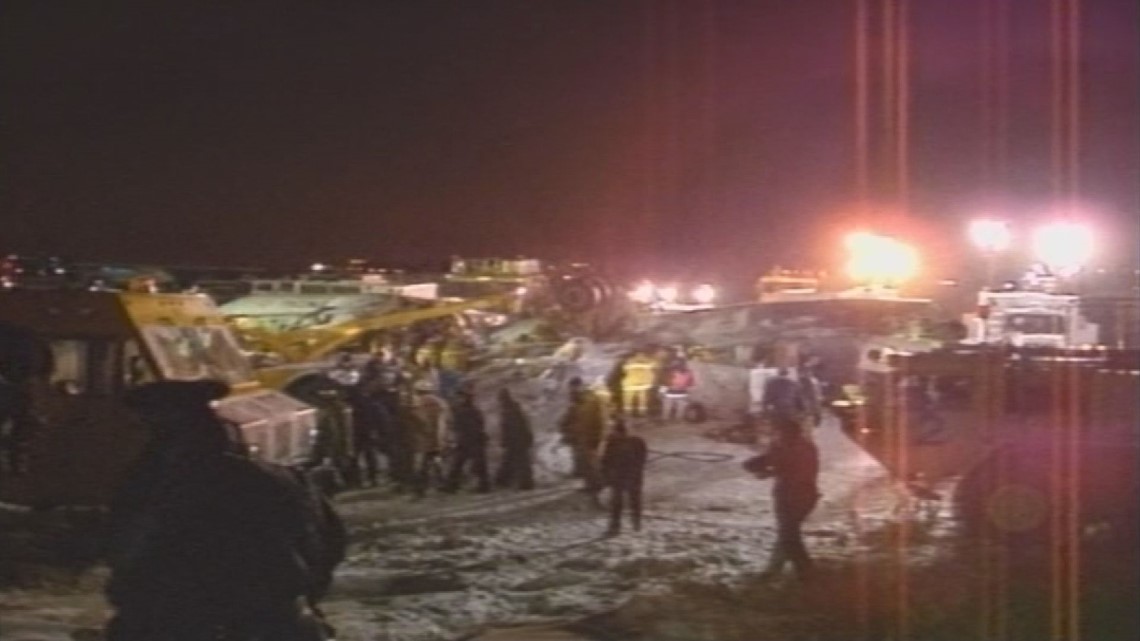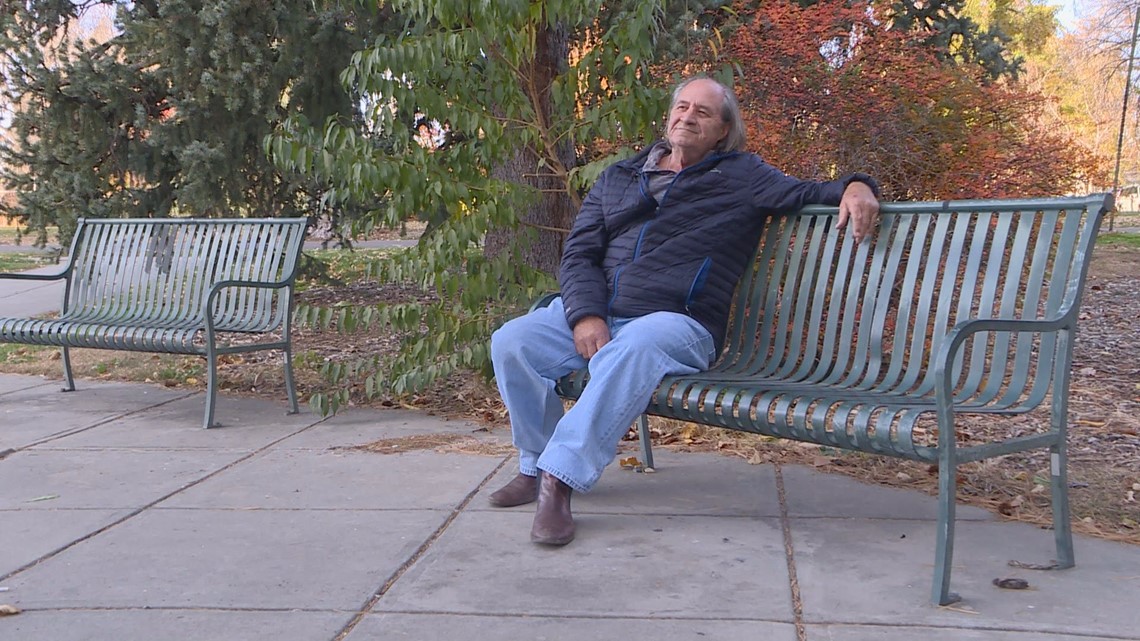DENVER — Joseph Pietrafeso spent more than 40 years working for Continental and United Airlines, some of that at the old Stapleton Airport in Denver, and one particular day sticks out in his mind: Nov. 15, 1987.
It was snowing, with freezing temperatures, when Pietrafeso, who now lives in Denver's Park Hill neighborhood, heard the news.
"Going home ... and a supervisor asked if I could help with a plane that had went off the runway," he said.
Continental Airlines Flight 1713 had done more than run off the runway. The Douglas DC-9 that was scheduled to fly from Denver to Boise, Idaho, broke apart, and pieces skidded across the snowy ground before coming to a stop. According to the crash report, 28 people lost their lives, including both pilots and a flight attendant. Another 28 suffered serious injuries.
It also was a crash that sparked changes to several flight procedures including deicing and the experience of the pilots in the cockpit.


What went wrong
According to the National Transportation Safety Board (NTSB) Aviation Accident Report for the crash, weather conditions were listed as "moderate snow" and freezing temperatures.
"November 15, 1987, was a snowy day in Colorado," said Greg Feith, 9NEWS' aviation safety expert, who has investigated aviation crashes for more than 40 years. "The airport was a lot smaller, and there was a lot of congestion because there were a lot of aircraft that were operating at Old Stapleton."
Because of the weather that day, pilots were responsible for letting those in the air traffic control tower know about their position on the taxiway, runway, de-ice pad and so on.
The crash report adds that "...both pilots were inexperienced in their respective crew positions."
The captain had 33 hours of experience flying a DC-9 aircraft as a captain, while the first officer had 36 hours of experience in the DC-9. Documents show that the first officer hadn't flown for 24 days; as a result, the first officer was assigned the trip to keep up with their skills.
"In this case, the crew departed the gate without a taxi clearance," Feith said. "So that began the ball of confusion with regard to the position of this airplane."
The plane had taxied out to the de-ice pad to be de-iced before the flight.
The crash report notes that after de-icing, there was a 27-minute delay between de-icing and takeoff. Company procedures called for "repeat deicing" if a delay exceeds 20 minutes. That didn't happen.
"Confusion between the tower and the flight crew due to procedural errors resulted in the delayed takeoff clearance," the report reads in part.
Upon takeoff, Feith explained that the first officer and had begun the takeoff roll but had "over rotated."
"He pulled back too rapidly and caused the nose to pitch up too fast. That in and of itself, with the contamination on the wings, ended up causing the airplane to get into an aerodynamic stall," Feith said. "The airplane rolled to the left. The left wing struck the ground. And the the disintegration process of that aircraft started to occur."


'You say a Hail Mary'
After hearing the news of a plane of the runway, Pietrafeso and a friend of his hopped in a van and sped off into the taxiways of Stapleton.
"And at that time, you just, you know, your heart, your stomach, everything jumps up into your throat and you don't know what to expect," he said.
The two, along with their supervisor, came up on the tail of the aircraft between the taxiway and the road. There was a break in the plane, Pietrafeso said. The tail of the aircraft was broken off in a snow-covered field near the runway, and the cabin upside down.
Pietrafeso realized how quickly they had arrived to the site of the crash.
"The the snow plows were there first," he said. "... We got there at the exact same time the fire department was getting there. And the snowplow people had taken the passengers and put them in their vehicles."
Pietrafeso says his job was to work a heater hose that went into the plane to provide heat for first responders while rescues were actively happening.
"I had to sit on that hose and put it in there while they were getting the people out, you know, so the firemen wouldn't get cold. And so the passengers wouldn't get cold either," he said. "You say a Hail Mary, and you just move on and, you know, do what you can, when you can, and the best that you can."
Pietrafeso is now retired. He said he has a strengthened respect for those in aviation.
"Yeah, I hope the best. God love them. You know, I wish them all the best," he aid.


Lessons learned
There were several factors that led to passengers surviving the crash. Feith said he believes one big factor was simply the weather that day.
"One, it was wintertime. Two, it was snowing relatively heavily, and three, the weather was very cold," he said. "That all aided in survivability because the fuel in the wing, as the wing disintegrated ... the fuel wasn't able to atomize, which normally causes these big fireballs. When you splashed that fuel out, that was mitigated by the snow and of course, the cold temperatures."
He said the way the aircraft crashed helped those in the back of the plane to survive.
"When you look at the way the the aircraft crashed, it rolled over," he said. "That in and of itself, the impact sequence was because the airplane was low, it didn't have a lot of energy behind it. So those people were able to survive.
"Unfortunately, the people in the front of the aircraft, they took the brunt of the initial impact because as the airplane took off and then rolled left," he said. "The first part of the airplane ... was the nose in the forward cabin section. So they had the highest energy, which negated their survivability."


The crash ended up changing several flight procedures, including those for deicing fluid and the discipline of flight crews on having their aircraft deiced, multiple times if necessary, Feith said.
He added that in this case, because there was a lot of air-traffic controller confusion, it wasn't made clear the flight had begun its taxi toward the runway.
To that end, technology has improved since then. Feith said Denver International Airport is a great example of that.
"Of course, out of that, we got ground-based radar for air-traffic controllers to really see now where all the aircraft are," he said. "Even if you can't see them visually from the tower, they can look on a screen and know where all those aircraft are."
The lack of experience of the two captain and first officer at the time of the crash led to improvements in the way airlines pair pilots, Feith said.
"You would never pair a new captain with a new first officer," he said. "You'd have him with a more seasoned first officer just because they have more operating experience, and vice versa."
Overall, Feith said the lessons of the crash have been incorporated into better training for pilots.
"[And] better operational discipline for pilots, better oversight by airlines, and, of course, for the airports trying to keep the airport open, if you will, by using all the technology that we have available so that we can mitigate or eliminate these types of accidents," he said.
SUGGESTED VIDEOS: Colorado’s History
9NEWS+
9NEWS+ has multiple live daily shows including 9NEWS Mornings, Next with Kyle Clark and 9NEWS+ Daily, an original streaming program. 9NEWS+ is where you can watch live breaking news, weather updates, and press conferences. You can also replay recent newscasts and find videos on demand of our top stories, local politics, investigations and Colorado specific features.
To download 9NEWS+ on Roku search for KUSA.
To download 9NEWS+ on Fire TV search for 9NEWS.

